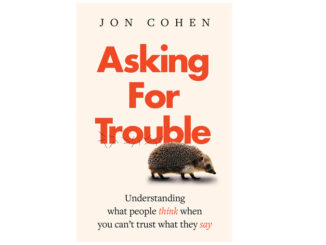By QRCA Emeritus Members Kathy Doyle, Martha Garma Zipper, Lisa McDonald, Tom Rich, Laurie Tema-Lyn, Paul Tuchman, and Jeff Walkowski
Dear Emeritus,
I’m an independent researcher who feels confident in my research skills but could use some client management strategies, i.e., best practices for managing scope creep, how to develop strong client relationships, how to “just say no,” etc. Can you share some pearls of wisdom that you think have contributed to your success?
~ Pondering in Philly
Dear Pondering:
You are wise to recognize the importance of honing client management strategies to achieve a successful research practice. The following tips are clustered in three core buckets. We hope you find them useful in optimizing your business success!
Develop Strong Client Relationships
Martha Garma Zipper, Laurie Tema-Lyn, and Paul Tuchman respond
 Build a reservoir of goodwill. Everything is easier when the client trusts you, respects you, and—never underestimate this—likes you. So, do all you can, especially with new clients, to make yourself indispensable. Don’t let yourself be just an order-taker (three focus groups in Boston on Thursday, please!) and, instead, make the client’s ideas even better. Demonstrate expertise and add value by suggesting creative approaches to the project’s scope, specs, methodology, techniques, and probes. Once you transition from supplier to partner, you gain more leverage and, more importantly, you cement a long-term relationship. That makes it so much easier to deal with the kinds of challenges you’re asking about. (Paul Tuchman)
Build a reservoir of goodwill. Everything is easier when the client trusts you, respects you, and—never underestimate this—likes you. So, do all you can, especially with new clients, to make yourself indispensable. Don’t let yourself be just an order-taker (three focus groups in Boston on Thursday, please!) and, instead, make the client’s ideas even better. Demonstrate expertise and add value by suggesting creative approaches to the project’s scope, specs, methodology, techniques, and probes. Once you transition from supplier to partner, you gain more leverage and, more importantly, you cement a long-term relationship. That makes it so much easier to deal with the kinds of challenges you’re asking about. (Paul Tuchman)
Never underestimate the power of staying in touch with clients and going above and beyond. For example, after the project has ended, make sure to send a “thank you” email or text when payment is received. If you have clients for whom you conduct research at least once or twice a year, make sure to check in periodically with a friendly reminder that you are thinking of them, e.g., “I’m looking forward to this year’s project” or “happy holidays!” (Martha Garma Zipper)
One way that I keep in touch with clients is to periodically forward an article that comes across my desk that I believe will have relevance to my client’s business needs. I find the most appreciated articles are often from media/sources that are not my client’s typical go-to places but may come from another category or industry different from the client’s. The caution is not to overdo this! (Laurie Tema-Lyn)
Make it all about what’s best for the client. Let’s be honest: sometimes it’s hard not to make it about you. You can’t imagine such a grueling travel schedule. You think that the discussion guide contains questions that will yield a frustrated group and, therefore, a burned-out qualitative research consultant (QRC). You’re dreading the struggle for feedback on such a confusing and unclear concept. But keep that your little secret. Make every suggestion through the lens of what’s best for the client: show them why they’ll get far more insights with a few changes; explain to them how their project will move more quickly; and/or that they’ll look better if you do it a different way. Create more opportunities for a win-win; a good QRC can figure out how to tweak things so the client, the project, and you all come out ahead.
Life is short. Careers are shorter. The relationships we build in our business life are, ultimately, what make the difference between a fulfilling work life and days filled with frustration. So, start strong, demonstrate your value and worth, and then use your carefully built reputation to stand up tall, be confident in yourself and, when needed, summon the strength to push back with positivity, creativity, and—never, ever forget this—a supportive approach and a friendly smile. (Paul Tuchman)
Manage Scope Creep
Kathy Doyle, Lisa McDonald, Tom Rich, Laurie Tema-Lyn, and Jeff Walkowski respond

When a client asks us to deliver something that is not in the original scope, our standard response is, “I’d be happy to do that for you! Let me get back to you with any additional costs and potential timeline shifts.” This lets clients know that we are very willing to accommodate their request and implies that we simply assume they realize their request is out of scope and will incur additional time and costs. One of three things happen: they wait to hear back from us, no questions asked; the request mysteriously goes away; or we have a conversation on how to prioritize/compromise to stay on track and within budget. (Kathy Doyle)
If I know a client has a history of asking for additional services and will be reluctant to absorb additional costs, I build in a scope creep line item. That way there’s no need to have awkward conversations about additional costs for additional work. (Tom Rich)
Often, I will take a project where I anticipate constant changes in scope based on past projects. I have been an independent qualitative research consultant since 1994. Scope creep still occurs, but with every client you learn what to include in the next proposal. There is truth to the saying “the devil is in the details.” For example, I just completed a project for a client that I work with often. This project had a high no-show rate for IDIs. There were 12 completed interviews with 5 no-shows that were rescheduled. I did not charge them extra this time, but next time I will include a provision for no-shows and rescheduling. (Lisa McDonald)
When I sense that there may be some scope creep occurring in the actual discussion guide, I’ll first express my concern that I might not have the ability to accommodate the additional requests given the amount of time we have budgeted with each respondent/group. I’ll go ahead and include the additional requests in the discussion guide and will show adjusted time estimates for the discussion to reflect these additional topics and/or questions. I make it clear that while my timing estimates are occasionally longer than the actual amount of time required, there is a possibility that there will not be enough time to cover all the additional material. I let them know that we can see how things go after the first one or two interviews or groups, then adjust as needed.
I also point out that if the guide is over-stuffed, and if all topics and questions must be covered, one way around it is to include some topics/questions in all interviews/groups and rotate other topics/questions into different interviews/groups. This offers clients the opportunity to collect the most pertinent data across all interviews/groups and additional insights in a subset of interviews/groups. This process shows flexibility on my part, allows the client to be actively involved in the process, and gives them the benefit of my many years of experience. (Jeff Walkowski)
Trying to fit far too many objectives and probes is a problem I’ve encountered numerous times. With decades of experience under my belt, I’m a good judge of assessing how much time it takes to probe and discuss topics, especially emotionally rich ones, in a manner that participants feel comfortable with and able to engage in. My clients are less likely to have this experience base to draw upon. I’ll gently suggest we do an exercise together in which we role-play talking through the guide and improvising a half dozen potential responses for each of the probes. We never have to go through more than a portion of the guide for the client to understand the need for editing or reprioritization of objectives. (Laurie Tema-Lyn)
Successful Client Negotiations
Lisa McDonald, Tom Rich, and Paul Tuchman respond

Oftentimes, the root cause of tension in client communications is that they tend to always be short on time and look to us to support their plethora of needs, often outside the scope of our projects and/or working arrangements. The only way I know how to manage this is with a team approach. I like to make sure that there are at least one or two people in addition to me who are prepared to take calls and handle requests. I’m a one-man show, so that often means I need to hire a field manager to be part of my project team. This costs money, of course, so I budget for that when costing out the study.
Set boundaries. This is often more easily said than done. If I need to have a boundary-setting conversation with a client, I’ll often prepare for it. I’ll write down what I want to say, and I might even write down things I want to be sure not to say. (Tom Rich)
Don’t just say no; push back on unfeasible requests with solutions and creativity. Sometimes we have to say no: “those wouldn’t be the best respondents for the objectives,” “that question won’t get at what we need for this topic,” “we’re not addressing the key objectives with this build,” or—my favorite—“it’s really difficult to do groups in New York and Los Angeles on back-to-back days.” But always be careful not to just say “no.” Push back with a creative alternative, like “here’s a better way to recruit the right people,” “we can afford to lose these questions to make room for what’s more important,” “what if we do New York first, regroup for a while, and then go to Los Angeles with new learnings that might steer us toward a different target and different topics and questions?” (Paul Tuchman)
As an independent moderator, you have the option of declining a project if it doesn’t fit within your boundaries or bandwidth. I know sometimes we are reluctant to turn down a project when things are slow, but you must weigh the pros and cons to ensure that you feel your work is valued and justly compensated. (Lisa McDonald)




